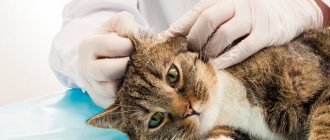Symptoms of the disease
Laryngitis in cats manifests itself in the same way as in humans. Colds and laryngitis have similar symptoms and treatment should be comprehensive. A pet owner should be wary if the following signs appear in a cat:
- loss of appetite;
- apathy, immobility;
- the appearance of wheezing in breathing;
- rapid breathing, shortness of breath;
- swelling and inflammation in the throat;
- slight increase in temperature;
- dehydration;
- dry cough, which later produces sputum;
- vomiting after coughing;
- The cat lies with its neck extended.
Cancer in a cat: symptoms
If you notice the following symptoms in your pet, you need to sound the alarm: - bleeding gums, bad breath, difficulty breathing, difficulty swallowing, signaling the presence of a tumor in the mouth or nasal cavity; - swollen lymph nodes, which may be a sign of lymphoma; - loss of appetite and weight; - non-healing ulcers and age spots on the skin can be a sign of skin cancer; - bleeding of any organ; - formations in the ears; - formations in the mammary glands; - apathy and decreased activity.
Causes of the disease
How can an animal get laryngitis? The disease is provoked by the following factors:
- drinking cold water or frozen food;
- prolonged exposure to cold, draft;
- dampness;
- presence of caustic substances or smoke in the air;
- allergy;
- past infectious diseases.
If laryngitis appears as a result of hypothermia, the animal’s condition can be improved by providing it with warmth and heated food. When the disease develops as a complication of bronchitis, pneumonia or a viral infection, treatment by a veterinarian will be required.
In the absence of medical care, the animal may die from suffocation, since the mucous membrane of the larynx narrows greatly.
Treatment of lymphadenitis in cats
You can choose effective treatment only by accurately establishing the cause of the disease. Therefore, the first thing to do is to make a correct diagnosis. To do this, you should contact a veterinary clinic.
If the infection is bacterial in nature, then antibiotics are prescribed to which this type of bacteria is sensitive. If the enlarged lymph nodes are caused by a fungal infection, then antifungal drugs are used.
In case of a viral infection, treatment must be prescribed by a doctor. The choice of drug is influenced by the condition and causative agents of inflammation. Most often it is bruneomycin.
If the animal’s condition worsens (difficulty breathing, fever and apathy), hormones are prescribed.
- - medicinal herbs;
- - echinacea tincture;
- - vitamin C;
- - antibiotics.
- - Activated carbon
- - sage, chamomile, calendula, lavender
- - Lugol's solution
- inflamed tonsils how to treat in 2018
- - sage;
- - eucalyptus;
- - chamomile;
- - pine buds;
- - anise fruits;
- - calendula flowers;
- - mint;
- - pharmaceutical propolis tincture;
- - carrot;
- - honey
- enlarged tonsils how to treat
- how to determine the presence of worms
- How do I know if I have worms?
- https://www.bengals.ru/zdor-s6.htm
- gum treatment for cats
- inflammation of the submandibular lymph nodes treatment
- and how to treat them
According to statistics, cancer in cats causes death in half of the deaths of these animals over the age of 10 years. A malignant tumor in cats can metastasize, which rapidly affects all healthy cells of a living organism. It is better to detect such a disease in cats in advance; in this case, it becomes possible for the animal to recover, and therefore increase its lifespan.
Treatment of the disease
The decision on how to treat laryngitis is made by the veterinarian. After examining the animal and taking blood for analysis, he prescribes laryngoscopy, based on the results of which, if the diagnosis is confirmed, therapy is prescribed. If there is severe swelling of the cat's pharynx, a tracheotomy is performed.
You cannot treat laryngitis on your own. Only a veterinarian can determine the pet’s condition and the cause of the disease. It is also forbidden to give your pet medications intended for treating people unless they are prescribed by a doctor.
Once the diagnosis is confirmed, treatment is prescribed depending on the cause of the disease. If the disease is triggered by an allergy, it is necessary to determine the allergen, otherwise the therapy will not produce results. You can get rid of the allergic form of the disease with the help of antihistamines.
In the absence of complications, laryngitis must be treated with antibiotics. Veterinarians prescribe vitamins, anti-inflammatory and painkillers.
As the disease progresses, you will need to put drops in the cat's nose. Drops containing menthol, peach and sea buckthorn oils will help make breathing easier. The duration of the treatment course is 7 days.
Treatment of this disease also involves treating the laryngeal mucosa with a solution of furatsilin.
The main recommendations from veterinarians to alleviate the symptoms of the disease are as follows:
- feeding liquid food that will not irritate the larynx;
- use of humidifiers;
- refusal to bathe an animal during illness;
- warming the larynx.
Diagnostics
The first step is to determine whether there is a viral or bacterial infection. A routine blood test will help you do this. If there is an increased number of white blood cells, bacteria may be present.
It is also necessary to conduct a serological blood test for calcivirus or herpes infection. Bacterial analysis is carried out by inoculating material from scrapings from the tonsils.
In cats, it is difficult to examine the pharyngeal cavity, so laryngoscopy is used for this - a special tube with a video beacon, which is inserted into the mouth.
It is also necessary to do a culture of the nasal discharge and mouth to detect chlamydial infection.
To exclude collapse of the trachea or the presence of a foreign body, an x-ray is performed to diagnose the neck area.
One of the first ways to help a cat with a sore throat is a special diet. Due to problems with swallowing and chewing, it is worth giving her only soft food, in the first days of illness - puree. Food should be warm and nutritious. Broths, vegetable and meat purees, as well as fermented milk products are suitable for these purposes. You can use baby food.
Provide your cat with peace. Try to move her sleeping place to a place that is not easily accessible, exclude active games and try to disturb the animal as little as possible.
Catarrhal form is treated by treating the throat with antiseptic solutions - furatsilin, a weak solution of potassium permanganate. You can treat the oral cavity with a spray or Lugol's solution.
If there is no purulent process (this is very important), you can apply local warming compresses to the neck area.
For viral infections, it is advisable to use immunomodulators - Maksidin, Immunofan, as well as adaptogens - Gamavit.
If tests show the presence of a bacterial infection, then antibiotic treatment must be prescribed. Amoxicillin and norulfazole are used for these purposes. The course should be at least 14 days with support from drugs for intestinal microflora (Lactobifadol, Bactoneotime).
Antipyretics (ketofen, Loxicom) and painkillers (aspirin) are prescribed symptomatically.
Cats should not be given paracetamol!!
Symptoms
In veterinary practice, we most often observe those that develop most suddenly (in the case of an allergic reaction). The animal suddenly becomes ill, the cat breathes heavily and wheezes, and screams in a voice that is not its own. In milder cases, the cat “simply” cannot drink or eat, and wheezes or “grunts” hoarsely and with whistling sounds.
It should be noted that owners of Persian cats and animals of similar breeds, even in this case, rarely begin to sound the alarm and you should not blame them for “callousness”. The fact is that these representatives of the cat tribe initially have difficulty breathing due to the special structure of the nasal cavities.
Anaphylactic shock is especially insidious. Roughly speaking, this is a type of allergic reaction. At the same time, the larynx swells so quickly and so much that the owners do not always have time to take the cat to the veterinary clinic... Thus, if your pet suddenly begins to wheeze, sniffle, behave inappropriately and suffocate, immediately go to the veterinarian.
So how to treat laryngeal edema in a cat? It all depends on the root cause that caused it. Since it is often an allergy, the cat is immediately given lethal doses of antihistamines. But what if he simply may not survive until the drugs take effect, having “safely” suffocated? In this case, intubation cannot be avoided. Since swelling sometimes cannot be relieved for quite a long time, your pet will have to “show off” with a plastic tube in its throat for a couple of days.
He will not experience any particular inconveniences... but you will feel them to the fullest, since you will have to feed the animal by pouring nutritional compounds into its throat. However, this is fraught with many unpleasant consequences, including aspiration of the lungs, and therefore it is better to take the animal to the veterinarian: he will not only assess its condition, but also intravenously administer a glucose solution or another mixture that will support the cat.
Alas, drug treatment may not help if swelling and destructive lesions of the larynx have developed as a result of some kind of autoimmune pathology. It is possible that you will have to undergo a rather complex operation aimed at restoring the functionality of the organ.
The cat meows, purrs, hisses. The sounds an animal makes have a reason. This is communication, expression of peace or displeasure, demands for attention and food. Siamese, Bengal cats and Sphynxes are especially “talkative”. Rarely, in exceptional cases, Maine Coons, Persians, Kuril Bobtails, and British cats speak. Training gives results. If you constantly turn to a cat, and this resembles a ritual after which the animal receives food and affection, then anyone will “talk.” Excessive meowing is annoying, but its absence should upset the owners more. What might cause concern? The cat’s voice has disappeared, the meowing is silent - this symptom often accompanies serious illnesses and injuries.
Basic information, predisposing factors
As you know, edema is the pathological process of fluid accumulation in cells and intercellular space. As a result, the affected organ swells, and in most cases its functionality deteriorates sharply. In general, the same can be said about laryngeal edema.
In severe cases, it swells so much that it completely blocks the flow of air, which can even lead to the death of the animal from suffocation. However, even in relatively simple situations there is little pleasure from this pathology, since the cat cannot eat or drink. In addition, the pet may be very nervous (which is not surprising), and stress only leads to aggravation of the process. By the way, what are the causes of this pathology? There can be quite a lot of them, but we will give the main list:
- Allergy. Perhaps the most common and insidious reason. It occurs suddenly, quickly, and is often fatal, since the swelling in this case may well completely block the entire windpipe.
- Poisoning, including from drugs or household chemicals. It often occurs in conjunction with an allergic reaction, and therefore leads to even more serious consequences.
- Autoimmune pathology. In general, this also includes cases of idiopathy: this is when the true root cause of the disease cannot be established.
Causes and risk factors
Among the causes of acute forms of laryngitis
note the following:
- ARVI;
- bacteria (staphylococcus, streptococcus);
- fungus (rarely, in patients with immunodeficiency);
- hypothermia (hypothermia);
- inhalation of chemicals;
- allergy;
- throat injuries;
- burn;
- ligament paralysis due to a stroke;
- GERD;
- pneumonia;
- tuberculosis;
- inflammation of the nasopharynx (rhinitis, etc.);
- dry air;
- metabolic disease;
- long course of antibiotics;
- stress.
Chronic laryngitis
due to:
- repeated laryngitis;
- constant load on the vocal apparatus (screaming, singing);
- frequent allergies;
- caries;
- pharyngitis;
- adenoiditis;
- prolonged sinusitis, bronchitis, tracheal pathology;
- long history of smoking (smoker's laryngitis), passive smoking;
- alcohol abuse.
If we talk about risk factors
, laryngitis is diagnosed more often in adults than in children. In addition, those at risk include those who:
- comes into contact with ARVI carriers;
- abuses alcoholic beverages and tobacco;
- is deficient in vitamins;
- has a weakened immune system;
- lives in unfavorable climatic conditions;
- consumes a lot of spicy seasonings, too hot or cold food.
Some people experience the costs of their profession, for example, singers, teachers, salespeople who need to work a lot with their vocal apparatus. They are predisposed to laryngitis because the vocal folds are subject to constant mechanical closure.
There is such a thing as whiplash, which occurs as a result of a collision (sudden flexion and extension of the neck or vice versa), which also contributes to laryngitis. Often found in road accidents.
Primary and secondary tracheitis
Primary tracheitis in cats is diagnosed very rarely; the pathological focus is located only in the mucous membrane of the trachea, and inflammation of only one organ of the respiratory system is observed. Much more often secondary tracheitis occurs, accompanying damage to other respiratory organs.
The following types of secondary tracheitis are distinguished:
- rhinopharyngotracheitis - inflammation of the mucous membrane of the nasal cavity, pharynx and trachea;
- laryngotracheitis - damage to the larynx and trachea;
- tracheobronchitis is an inflammatory process of the mucous membrane of the trachea and bronchi.
Prevention measures
It is much easier to prevent any disease or disease than to treat it, especially if the disease has become chronic.
Prevention in cats involves:
- Systematic proper care of your pet.
- Creation of optimal conditions of detention.
- Compliance with immunization and deworming schedules.
- Balanced nutritious diet.
- Caring attitude towards the cat.
- Completing preventive examinations at the clinic twice a year, especially for older cats, animals with congenital defects, and nervous pathologies.
Avoid hypothermia and overheating. Do not keep the animal in drafts. If your cat is walking down the street, after the walk, examine your pet for injuries, wounds, or parasites.
What is tracheitis and why is it dangerous?
If your cat or kitten has a severe cough, you should immediately contact a veterinarian.
The trachea in cats is formed by cartilaginous rings connected by elastic ligaments. The organ of the respiratory system is a hollow tube connecting the larynx and bronchi. When you inhale and exhale, the air passing through the trachea is warmed, moistened and cleared of harmful particles. The interior of the respiratory organ, like all organs of the respiratory system, is lined with mucous membrane.
With the development of inflammation of the trachea in cats under the influence of various infectious and non-infectious factors, tracheitis develops. The disease occurs against the background of severe swelling of the inner lining of the respiratory organ and an increase in the production of mucous secretion.
The disease can have an acute and chronic course, both forms are accompanied by a debilitating painful cough and general intoxication of the body.
Interesting! The inflammatory process of the trachea is not always associated with the activity of pathogenic bacteria and viruses; often the animal becomes ill due to the fault of the owner when feeding and housing conditions are violated.
If the disease occurs in isolation, and the pathological focus is located only in the hollow organ of the respiratory system, we are talking about primary tracheitis. But most often, cats are diagnosed with secondary tracheitis, accompanied by inflammation in the nasal cavity, pharynx, larynx or bronchi.
The danger of untreated tracheitis lies in the possible development of complications. Pathogenic microflora from the organ of the upper respiratory system quickly descends into the bronchi and lungs, which is fraught with the occurrence of bronchitis and bronchopneumonia.
Infectious tracheitis in kittens and young animals has a very high percentage of fatal cases. Purulent sputum released when coughing and ingested by an animal can cause inflammatory diseases of the gastrointestinal tract. Severe tracheitis, accompanied by damage to all tissues of the respiratory organ, leads to suffocation and instant death of the animal.
Examination and treatment at home
If your pet begins to cough, his voice disappears and he begins to feel sick, you can try to help him at home. This is possible if the owner is able to independently eliminate the cause, for example, move the animal to a ventilated room or remove a foreign body from its throat. Examination of the larynx allows one to draw primary conclusions about the cause and condition of the animal. If your throat is red and swollen, it is most likely due to an allergy or infection.
First aid
You can give your pet an antihistamine, for example, Tavegil or Suprastin, they will help slightly eliminate the first symptoms before being examined by a doctor. A cold or infectious disease, for example, laryngitis, requires complex treatment, which must be carried out by a veterinarian.
For a while, it is worth excluding food and products that can cause allergies from your cat’s diet. It is necessary to ensure constant access to water, especially when it comes to dehydration.
We suggest you read: Poisoning in cats: symptoms, what to do and how to treat? First aid for a pet
Treatment of cancer in cats
Treatment for cancer in a cat will depend on the type and extent of the disease and the general condition of the animal. The doctor may prescribe: - surgery; - chemotherapy; — irradiation (radiotherapy); — immunotherapy.
It is important to understand that the medications used to treat cancer are very active and your cat will feel very unwell after each treatment. However, this does not mean that the treatment is harmful to her. The improvement will not be noticeable immediately. The animal may vomit, sleep most of the time, or meow restlessly. The cat’s behavior after the procedure should be discussed with a veterinarian, who will explain to you whether this is normal and whether treatment should be interrupted.
The doctor will also advise you on how to properly feed an animal suffering from this disease. Your cat's diet will largely depend on the type of cancer she has. Many animals with liver cancer refuse to eat. In this case, it is recommended to feed him with a syringe (without a needle, of course), pureed soft food.
It is necessary to ensure that the cat does not lose weight. The veterinarian may prescribe painkillers and substances to make food easier to digest, injections or drips.
Cancer with metastases can be very difficult for a cat to survive. In this case, the oncologist may recommend that you resort to euthanasia - humane euthanasia, which saves the animal from inevitable suffering. This is a very difficult decision and you will need the support of your family and loved ones.
Lymph nodes guard human health. Millions of different cells pass through them every day. Foreign bacteria settle in the lymph nodes. If everything is in order in the body, then the lymph nodes are of normal size; when a certain virus is introduced into the blood, they will increase, trapping and digesting pathogenic cells.
What it is?
This disease (at least in its “classical” form) does not occur particularly often, since in many cases the inflammation “slides” into the lower parts of the respiratory organs. The etiology is quite vague.
Often inflammation begins after the activation of conditionally pathogenic microflora, which occurs against the background of severe hypothermia in the cat’s body. So in cases where it is -15 Celsius or lower outside, or (as in coastal areas) there is very high humidity and strong wind, try not to let your pet out for a walk. In general, in such weather, cats are not particularly eager to go there.
Infectious laryngotracheitis is a more “classical” variant of the disease. Often its appearance is caused by carnivore plague and other infectious pathologies of a bacterial, viral or fungal nature.
Unlike bronchitis and pneumonia, helminthic infestations are the cause of laryngotracheitis extremely rarely (there are practically no such cases recorded at all). During their migration from the lungs to the gastrointestinal tract, the larvae of worms practically do not irritate the larynx and trachea, so they do not come under attack.
What are the consequences?
If symptoms are not identified promptly and treatment is not started, feline laryngitis is dangerous with the following consequences:
An advanced disease in a pet can develop into bronchopneumonia.
- Swelling of the larynx. The condition threatens the life of the animal, as death from suffocation can occur.
- Sore throat in cats. Occurs when pathogenic microflora spreads to the tonsils. The disease is dangerous due to the development of infectious myocarditis.
- Laryngotracheitis and bronchopneumonia. Complications occur when the inflammatory process spreads to the lower respiratory tract. Leads to oxygen starvation or death.
- Abscess. Characterized by the formation of a cavity filled with pus. Promotes the development of phlegmon or sepsis, which leads to the death of the animal.











